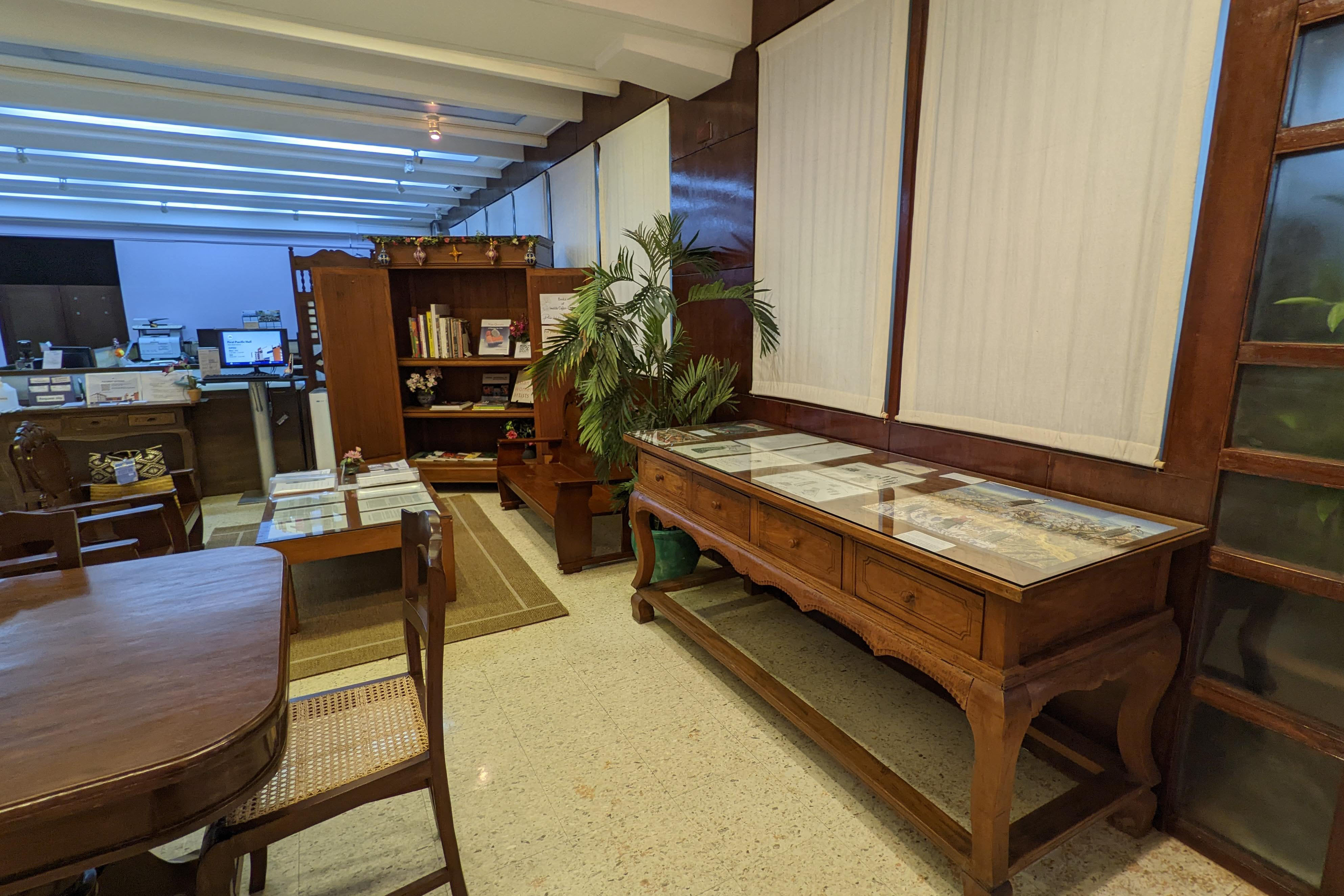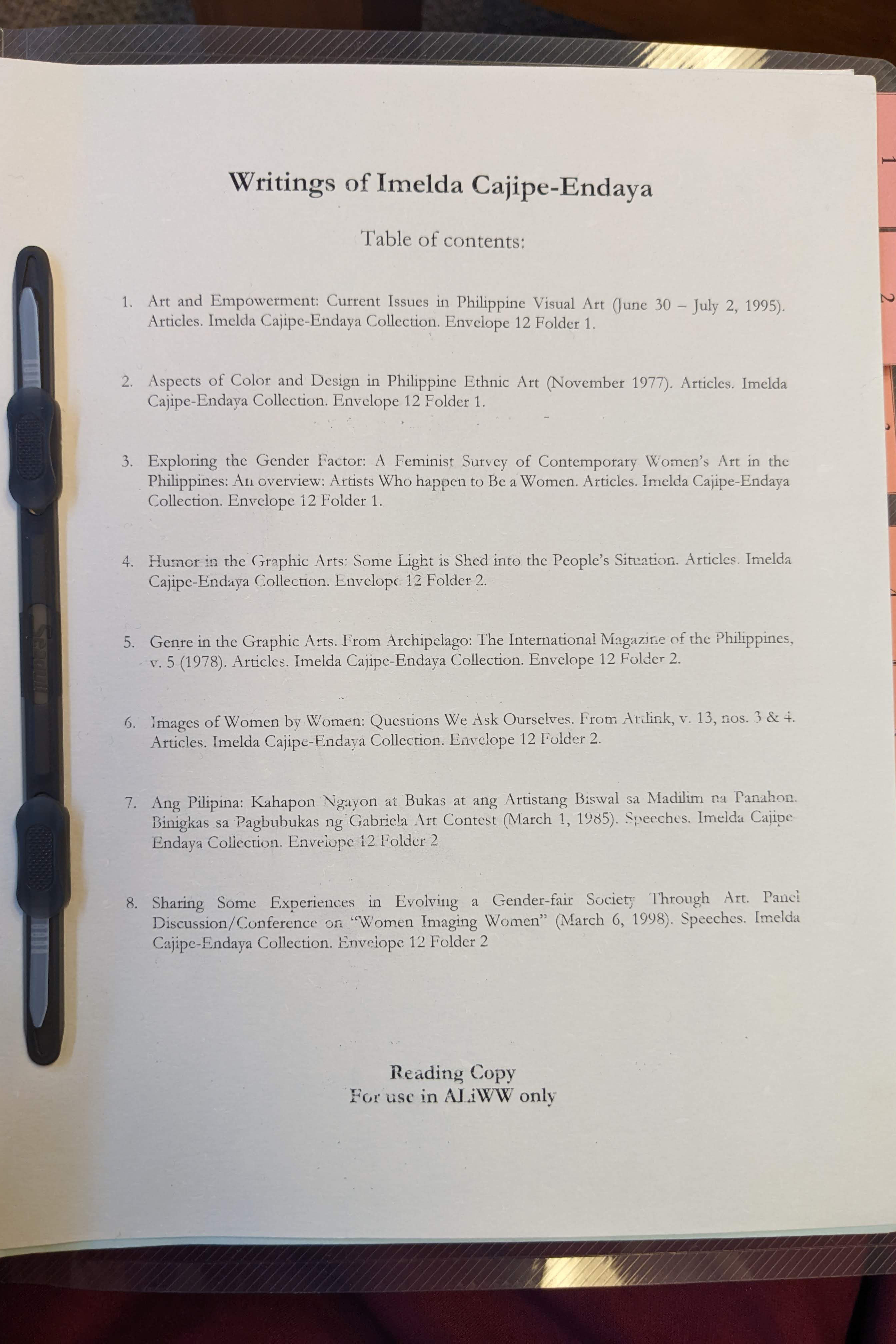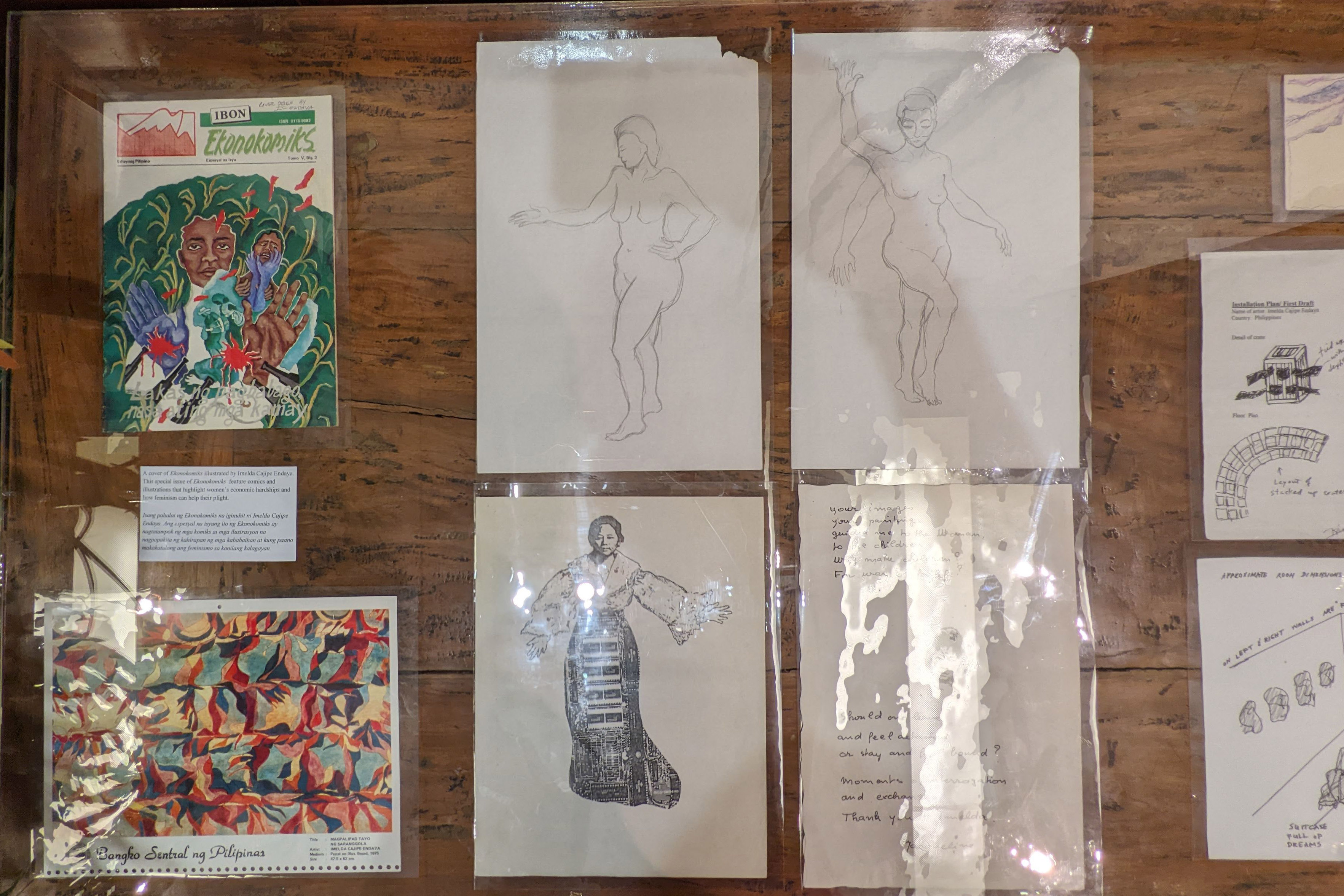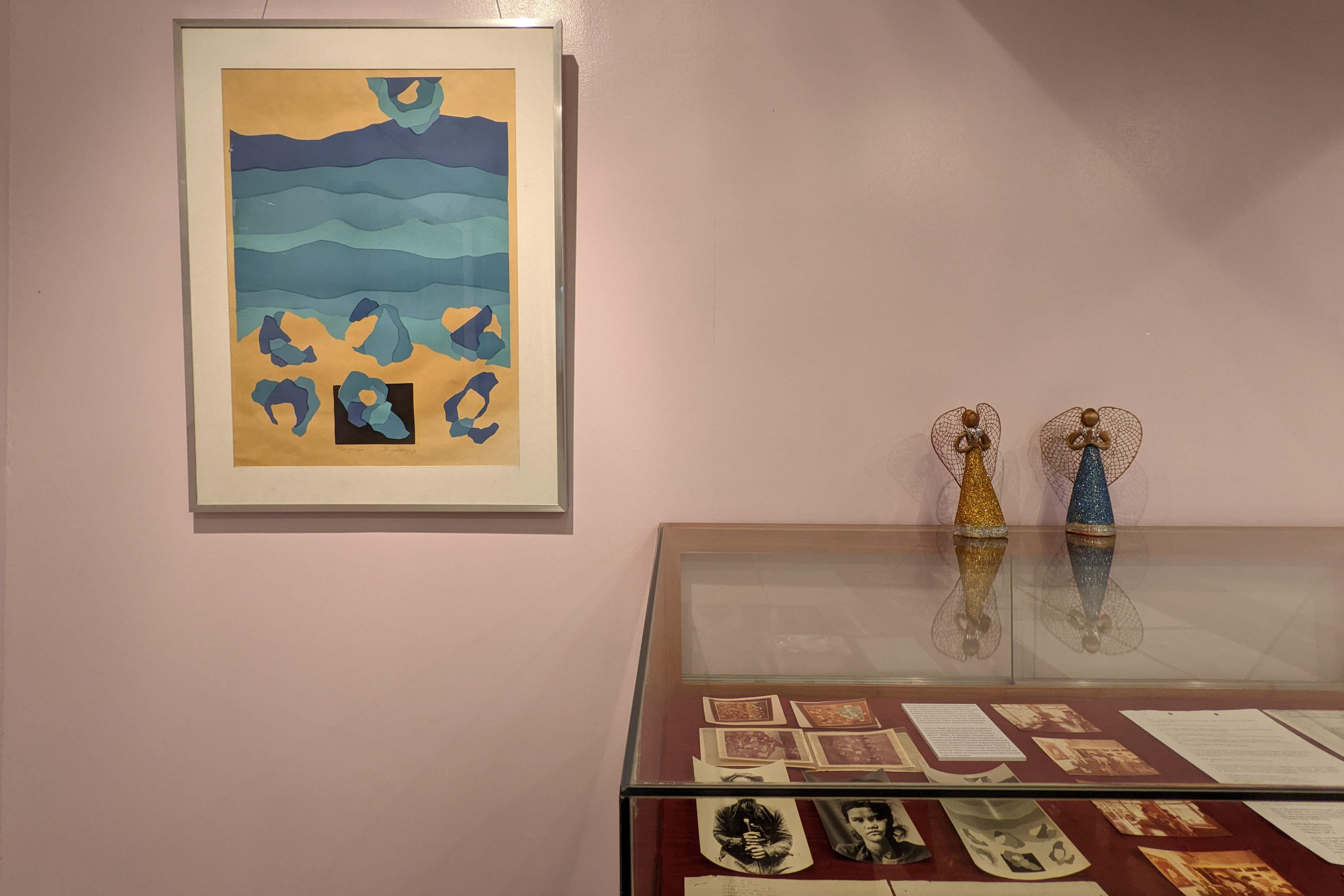Providing a glimpse into Imelda Cajipe Endaya’s archival materials at the Ateneo Library of Women’s Writings (ALiWW), Windows to an Archive is an enriching supplement to understanding her decades-long art practice. If the retrospective at the CCP is the after – the product of her artmaking, then the offsite exhibition at ALiWW is the before – the ingredients brewing in her consciousness as she made her art. Not only the before, but also the after of the after – the documentation of what has been made, the then-present captured in writings, photographs, books, and other ephemera. If the retrospective shows Cajipe Endaya as a prolific artist, then this exhibit reveals different sides of her: a fastidious archivist and a reflexive writer. As Elisabeth Kaplan[1] posits, the archives is a window to one’s identity; in her words, “We are what we collect, we collect what we are.”
The archives is not only a repository that reflects the selfhood of its creator or custodian. To expound its possibilities, Randall C. Jimerson[2] offers three imageries: a temple, a prison, and a restaurant. Such facets are manifested in Windows to an Archive exhibit that displayed a well-considered selection of less than a hundred materials from over a thousand archival items in ALiWW’s Cajipe Endaya collection.
A Temple
Beyond its functional purpose it reminds you that you are entering a sanctum, a domain of being that is larger than yourself.
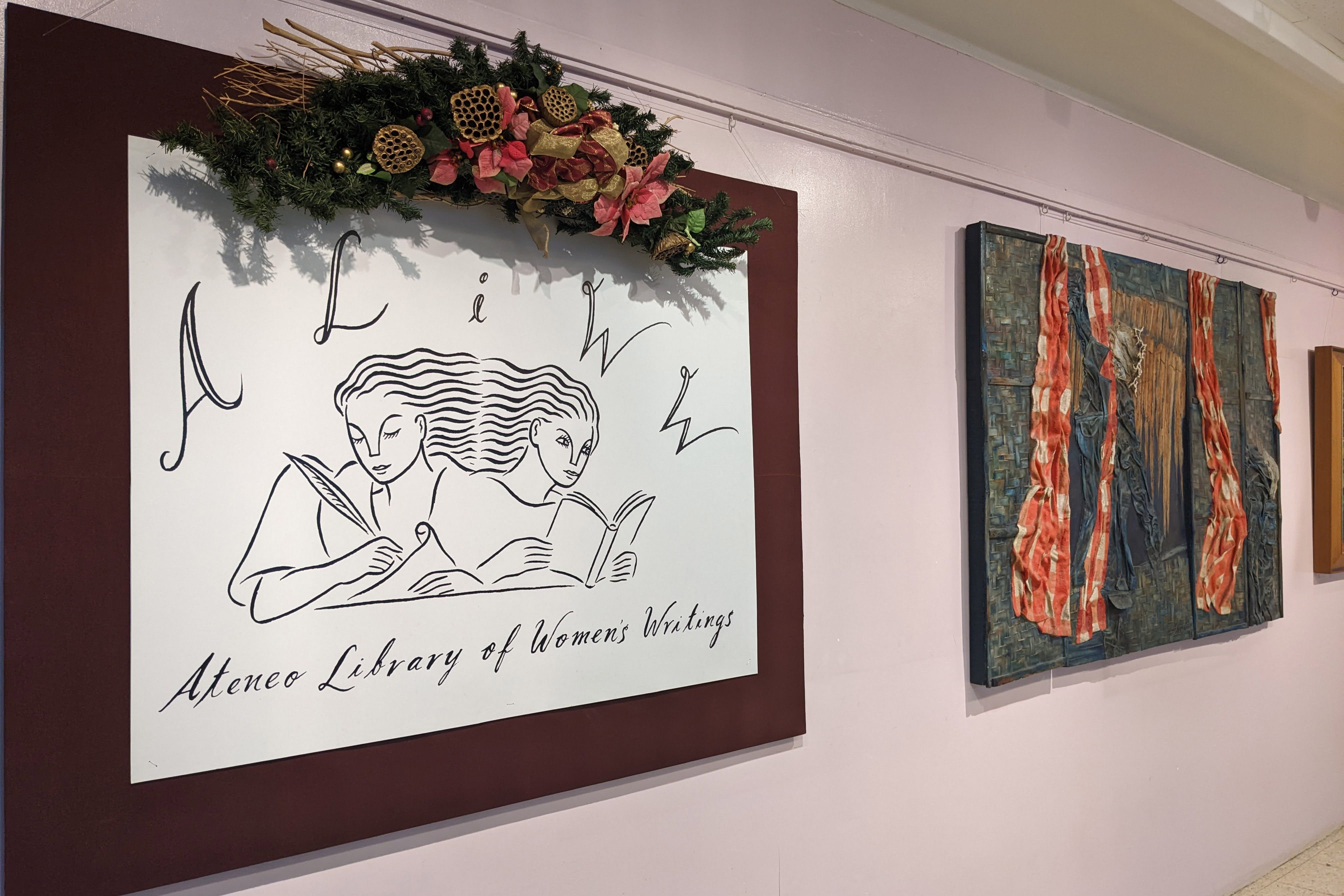
Stand in front of ‘Bintana ni Momoy,’ the first work you see upon entering the space, and you have the whole view of the exhibition. The position of the collage window externalizes the title Windows to an Archive: it is a literal portal to the artist’s archive. That you can see the full view of the exhibit from this perspective, serves to emphasize the fact that this space is relatively small compared to the main show at CCP. What it lacks in space, it makes up for the breadth of materials. Like a window, the exhibit presents a larger world outside our own: the outer world the artist inhabited that influenced her inner world of abstraction and realization, all elements synthesized in her artmaking.
Aside from the implications of the magnitude of the knowledge stored in it, the archives is also a temple through which “records of human activity achieve authority and immortality” seeing as “archivists make value-laden decisions with momentous implications for the knowledge that the future will have of the past.” For any archive, whether institutional or personal, considerations on what materials to appraise or acquire ultimately depends on the histories that they want to carry towards the future. For ALiWW, the inclusion of Cajipe Endaya, who herself has multitudinous contemplations about womanhood, aligns with their intention to preserve writings by and about Filipino women.
A Prison
Both in their design and operation, archival reference rooms echo […] panopticism, ensuring security and control. This “panoptical archive” extends even to the physical ordering of records and “the knowledge-power of the finding aids, as representation of what the public may not see openly, but may expect to find behind the closed doors of the prison-like repository.”
From ‘Bintana ni Momoy,’ easily recognizable to the right is a bookshelf containing over thirty books from the artist’s library and a reading corner with printed articles on the table. One of the displayed documents is titled ‘The artistic path I have taken’ where Cajipe Endaya explains the representation of windows in her works:
I used the window as leitmotif for my work. The window is a symbol of woman sheltered by biological fate and patriarchal culture to the confines of home. But my windows are flung open for woman to behold social obstacles and spiritual reflections.
This time through her words, we are presented with another window. The article is a view of the universe of women in art and society through her collected books and personal writings. Honing in on this, situated opposite the aforementioned article is another piece of writing titled ‘Ang Pilipina: Kahapon Ngayon at Bukas at ang Artistang Biswal sa Madilim na Panahon.’ On the shelves, the book ‘Asian Women Artists’ is prominently displayed. Back again on the table, there are two plastic file folders each containing photocopies of eight chosen writings from her archive. The table of contents lists the article titles, and interestingly, a note in the form of “Envelope 12 Folder #” specifies their location within the archive. Looking into the finding aid that is linked on the exhibition pamphlet, one would see that the eight featured writings from Envelope 12 are among the 28 items under Series X classified as papers or essays by the artist. More than being an inventory list, the finding aid is helpful in archival research because it gives a bird's-eye view of the collection by documenting pertinent information such as the background of the creator, dates of creation, and kinds of material (e.g. articles, photographs).
In Jimerson’s metaphor of the archives as a prison, the finding aid is a way to take stock of the items that should be safeguarded. For him, it is important for the archives to put security measures to preserve and protect its holdings, given their conferred value in the future. In the exhibition, this is realized through glass casings and plastic enclosures for some paper records, and of course a member of staff present in the location.
The structural integrity of archival material was also crucial to the exhibition team at the CCP when they had to recreate some of Cajipe Endaya’s site-specific installations. For ‘Kapatiran ng Lakambining Maybahay Redux’, curator Con Cabrera shared that they had to paint the draped component because the redness of the cloth did not match the shade on the reference photo. Curatorial choices that rely on archival records, like those made by Cabrera and Acuin, demonstrate the importance of the 'archival prison'. Perhaps, a photograph of this exhibit would be needed as well for a reason unknown at the moment, only in the future. Such is the nature of how value is generated within the archives.
A Restaurant
Unlike human memory—which actively processes, suppresses, and distorts traces of past experience—material placed in archives “just sits there until it is read and used and narrativized.”
After poring over the writings of Cajipe Endaya in the reading area, you again glance upon ‘Bintana ni Momoy’, mounted on the center wall. To its right is the painting ‘Babae’ and the serigraph ‘Ebolusyon’ now on their adjacent wall. Near the serigraph is a glass casing that contains photographs and writings related to the three aforementioned artworks, including an annotated poem by Hilario S. Francia that articulated the sentiment of Cajipe Endaya’s Bintana collection.
Next to this is another glass enclosure that showcases her research notes and materials and a vertical standing bookshelf, both containing focusing on women in art and history. One of the documents in the enclosure is ‘Cajipe Endaya on Cajipe Endaya’ which mentions the term “art of refusal” which curator Lara Acuin shared as the basis for the translation of “Pagtutol” in the retrospective’s title. Dated September 28, 1996 and published on a now-defunct website, the artist wrote:
Third World art, I realized, manifests not only a national identity or distinct regional style, but more importantly, a kind of "humanistic ferment." It is, to borrow a phrase from writer-activist Dolores Feria, an "art of refusal" which sums up the "total human spiritual values of a people's struggle against domination in the cultural, political and economic spheres" by the First and Second World Powers. That phrase aptly describes the direction of my art since 1983.
“Art of refusal”, a phrase from an article within more than a thousand archival records in Cajipe Endaya’s archive, gained a new life 26 years after the article was published, and 17 years after the artist donated her collection to Ateneo in 2005. Echoing Steedman, the words just sat there until it was read by the archivists and curators, then used and narrativized in the retrospective. This act extends to all materials chosen to be part of Windows to an Archive wherein their presented narratives in the present evidenced the consistency of Cajipe Endaya’s intentions from her artifacts in the past.
A Window
Before leaving, the poem that captured the spirit of Cajipe Endaya’s window motif begs for another reading. A stanza stands out:
Is it not more prudent to observe
from a distance?
But you must also do
what must be done!
Seria’s Window (After a collage by Imelda Cajipe Endaya)
On the bottom left of the typewritten document, using a blue ballpen, the poet also scribed: “Meps, Pls. call me when you have something ready. Thanks, regards, Larry”
It’s as if it’s a message to you – not by the poet or the artist but by the archives. It is open, rife with possibilities, just waiting for an eager curiosity to discover an exciting space that is simultaneously a temple, a prison, and a restaurant.
Borrowing how Jimerson closed his article, you leave with an invocation:
May our archival temples truly reflect values worthy of veneration and remembrance. May our archival prisons minimize locks and security and emphasize accountability, preservation, and access. May our menus be clear and understandable, and our table service efficient, thorough, and helpful.
Windows to an Archive is open for viewing until December 2, 2022. To visit the exhibition, sign up on https://go.ateneo.edu/RLRequestForm. Choose “ALiWW Exhibit Guests / Library Tour” and upload the poster as the invitation attachment. For more information, please see this Facebook post on ALiWW's page.
Lk Rigor is currently pursuing MA Art Studies in UP Diliman. Aside from being a curator, she dreams of becoming a cat lady someday.
Images courtesy of the writer.
Notes:
1 Kaplan, Elisabeth. “We Are What We Collect, We Collect What We Are: Archives and the Construction of Identity.” The American Archivist, vol. 63, no. 1, 2000, pp. 126–51. JSTOR, http://www.jstor.org/stable/40283823.
2 Jimerson, Randall C. “Embracing the Power of Archives.” The American Archivist, vol. 69, no. 1, 2006, pp. 19–32. JSTOR, http://www.jstor.org/stable/40294309.

